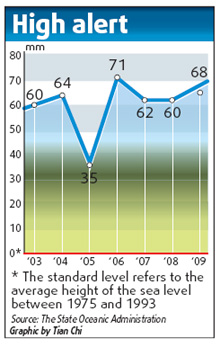China sea levels reach record high
The sea level in China late last year hit a record high for the past three decades, threatening the safety of thousands of people in the coastal areas, the national ocean agency said yesterday.
The average rise in sea level for the past three decades occurred at a rate of 2.6 mm a year, much higher than the average rate of 1.7 mm annually across the world, a report on the sea-level rise in China for 2009 released by the State Oceanic Administration (SOA) showed.
"Last year, the sea level was 8 mm higher than 2008 with the rise in sea level in Hainan Province reaching 113 mm, the highest across the country," Lin Shanqing, director of forecast and disaster relief department of the SOA, said yesterday.
Extreme weather like high temperatures and monsoons play an important role in the rise in sea level, Lin said.
In mid August last year, high temperatures hit most parts of southern China, causing the sea level in September to become about 180 mm higher than the previous year and pushing the oceanic temperature to 28.5 C, the second highest record in the past three decades, the report showed.
Experts estimate that the sea level, along the country's coastal areas, will keep rising and a maximum of 130 mm a year is very possible in the next three decades.
In order to avoid the possible damage caused by the rise in sea level such as storm tides, coastal erosion, seawater encroachment and soil salinization, officials from the SOA suggested authorities of coastal cities improve sea level monitoring systems and take the impact of the rise in sea level into account when making plans for economic development.
"The Yangtze River Delta, the Pearl River Delta, the Yellow River Delta and coastal areas of Tianjin are the country's most economically developed regions and are potential areas that could suffer from the impact of the rise in sea level," Xu Sheng, director of the National Marine Data and Information Service, told China Daily.
"Local authorities of the coastal areas should build higher dams and take environmental protection measures to slow down the rise of the sea level," Xu said.
 |
|
[China Daily] |
For island countries such as the Maldives, a sea-level rise of only 1 m is a matter of life and death.
More than 70 percent of the world's population live on coastal plains and 11 of the world's 15 largest cities are on the coast or estuaries.
Rajendra Pachauri, chairman of the Intergovernmental Panel on Climate Change, said in Copenhagen on Dec 7 last year that the goal of keeping global temperature increases below 2 C this century would lead to a sea-level rise of 0.4 to 1.4 m. Add on the effect of melting of snow and ice and several small island states and Bangladesh will be submerged.
A number of experts at Oxford University also predicted that a rise of at least 2m in the world's sea level is now almost unstoppable due to man-made greenhouse gas emission, unless the planet is cooled.
 0
0 







Go to Forum >>0 Comments